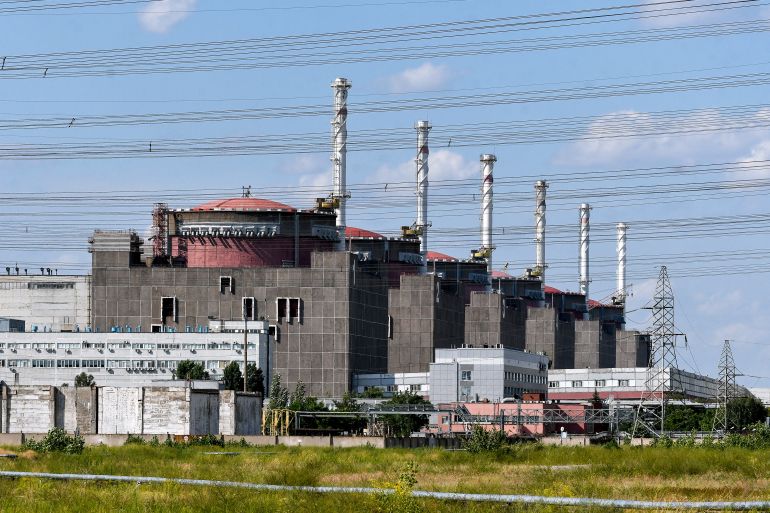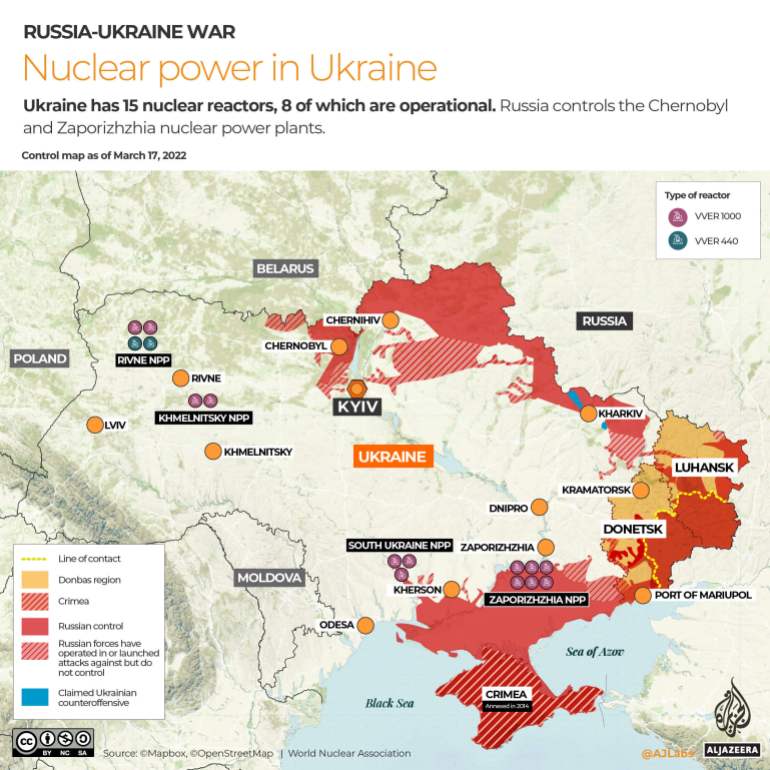Is a nuclear disaster likely in Ukraine?
The IAEA and nuclear experts warn Ukrainian nuclear sites are at risk following Russia’s invasion. Is a major nuclear incident possible?

On the first day of Russia’s three-week-old invasion of Ukraine, Moscow’s troops took over the Chernobyl nuclear facility, the site of the world’s worst nuclear accident.
A little more than a week later, Zaporizhzhia Nuclear Power Plant, Europe’s biggest, was also attacked and overrun by the Russian army.
Keep reading
list of 4 itemsUkraine agriculture minister released on bail in $7m corruption case
Russia-Ukraine war: List of key events, day 792
Risk of military incidents on Belarus-Ukraine border quite high: Lukashenko
The shelling of some of its facilities caused a fire to break out, but no increase in radiation was reported. Meanwhile, at Chernobyl, near the border with Belarus, early reports of a spike in radiation were attributed to heavy military equipment stirring up contaminated soil near the site.
The attacks triggered widespread alarm. The International Atomic Energy Agency expressed “grave concern” about the security of Ukraine’s nuclear sites, warning that the fundamental principles of safely operating such facilities had been violated at the two captured sites. And, as President Volodymyr Zelenskyy warned of a looming nuclear disaster, people across Europe with memories of the 1986 Chernobyl disaster rushed to buy iodine tablets to take in case of radiation exposure.
On March 10, IAEA chief Rafael Grossi flew to the Turkish city of Antalya to meet Russian foreign minister Sergey Lavrov and his Ukrainian counterpart, Dmytro Kuleba. Grossi put forward a “framework to ensure the safety and security of nuclear facilities in Ukraine”, but it remained unclear whether the two sides agreed to it.
While nuclear experts Al Jazeera spoke to say a nuclear incident on the scale of the 1986 Chernobyl disaster is unlikely, they warn that the fighting in Ukraine does pose a threat to its nuclear sites.
‘Nuclear facilities at severe risk’
With a well-developed nuclear energy infrastructure, Ukraine is the world’s seventh-biggest producer of nuclear energy. Some 55 percent of the electricity it produces is nuclear, generated by four nuclear plants.
The fifth one, Chernobyl Nuclear Power Plant, had its last functioning reactor shut down in 2000. The decommissioned plant, however, needs daily maintenance as a number of safety systems are still in place and spent fuel is still stored at the site.

A team of about 211 personnel and guards who were on shift when the plant was captured on February 24 have not been able to leave since and be replaced by other staff, potentially undermining their ability to safely operate the facility.
The electricity supply to the plant was also cut off on March 9, forcing staff to switch to diesel generators, before engineers on March 14 reconnected the facility to the power grid. The IAEA also reported on March 9 that it had lost its connection to safeguard systems at Chernobyl that monitor nuclear material.
The nuclear watchdog has also expressed concern about the conditions in which the Zaporizhzhia plant in Ukraine’s south is operated, as its staff is also unable to rotate as safety procedures stipulate. Its direct connection to observation systems at the site was also cut off, although it said in recent days it was able to receive data. It also reported that Russian troops were detonating unexploded munitions found at the site of the March 4 shelling.
According to Nikolai Sokov, a senior fellow at the Vienna Center for Disarmament and Non-Proliferation, the fact that there has been no major incident so far at the two captured sites shows that both sides have been careful – but a nuclear incident could not be ruled out.
“Nuclear power installations are designed for peacetime. This is the first time we see major fighting in a country with lots of such facilities. This is a unique situation that no one prepared for,” he told Al Jazeera.
Is a nuclear incident likely?
While nuclear plants are built with high safety standards to prevent possible disasters, there are still a number of vulnerabilities.
The Chernobyl facility does not have any functioning reactors and the one that exploded in 1986 has been buried in a concrete sarcophagus. However, the site still poses a danger to its immediate environment.
According to Allison M Macfarlane, professor and director at the School of Public Policy and Global Affairs in the University of British Columbia, if the spent fuel storage facility is damaged or operated improperly, due to staff fatigue, lack of electricity, or the cooling system being out of order, this could lead to the release of radioactive material.
Such an incident would have a more localised impact and would not spread radiation to vast areas near Ukraine, as the 1986 disaster did, Macfarlane pointed out.
However, heavy fighting during the war could cause a much more serious incident at the four functioning nuclear plants.
The nuclear reactors currently operating in Ukraine have a sturdy concrete and steel structure that is meant to contain radiation and withstand outside pressure. According to Georgi Kaschiev, a nuclear physicist and former head of the Bulgarian Committee for the Peaceful Use of Atomic Energy, the reactors’ cover can withstand an explosion caused by a shell, but nothing more sustained.
“The main threat is that bombardment with rockets could damage vital systems of nuclear sites,” he said. Those could be either the power supply to the plant or apparatuses that help operate the reactors. If the cooling systems of a plant break down, this could have severe consequences, Kaschiev warned.
In his view, even if the Russian military leadership understands these risks and takes precautions, troops on the ground could still engage in dangerous military activities that could damage nuclear facilities, the same way forces in July 2014 struck a civilian aeroplane over a part of eastern Ukraine held by pro-Russian separatists using what investigators and prosecutors have found to be a Russian-made surface-to-air missile.
Both Kaschiev and Sokov said a nuclear disaster at Ukraine’s functioning nuclear plants of the same scale as Chernobyl, which affected most of Europe, is highly unlikely. Kashchiev pointed out that the extent of the fallout would depend on the ability of local staff and authorities to implement safety procedures to contain radiation.
For Macfarlane, nothing can be ruled out amid the unpredictability of war and she expects Russia to continue targeting Ukraine’s nuclear sites.
“Because these facilities provide over 50 percent of electricity for Ukraine, I imagine that they are very attractive targets for the Russians because they would like to be in control of the electricity,” she said.
Follow Mariya Petkova on Twitter @mkpetkova